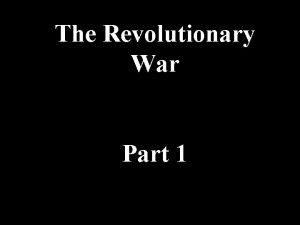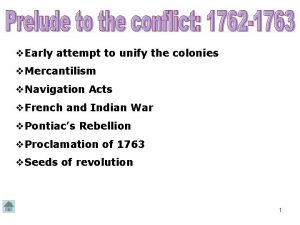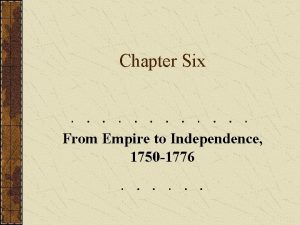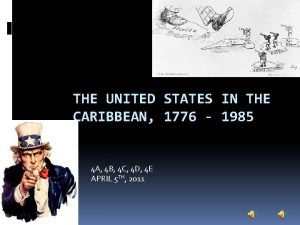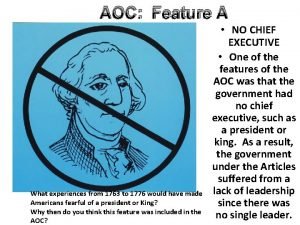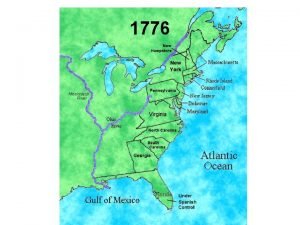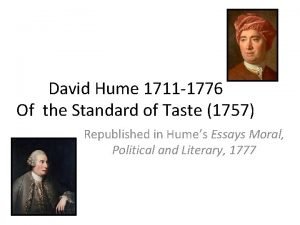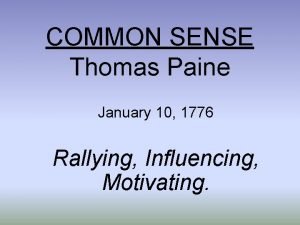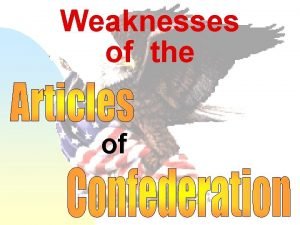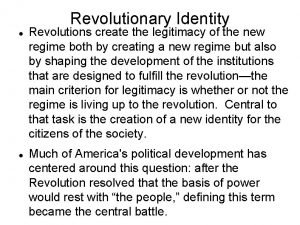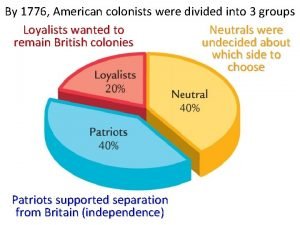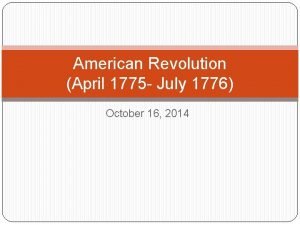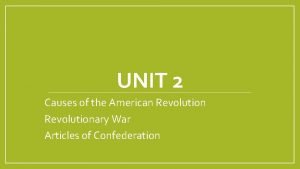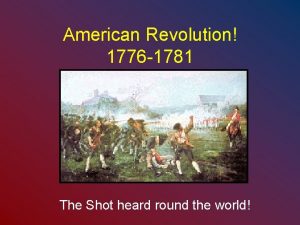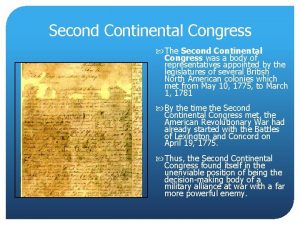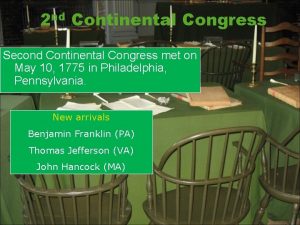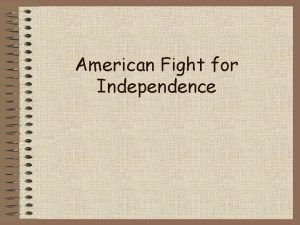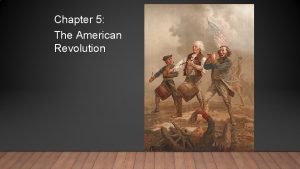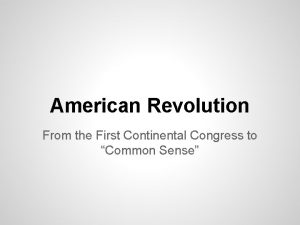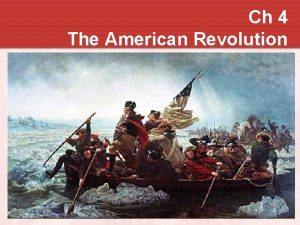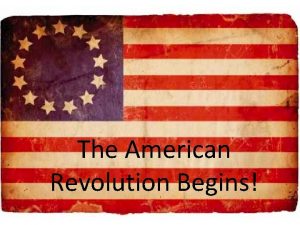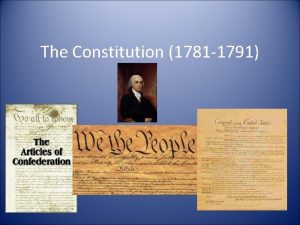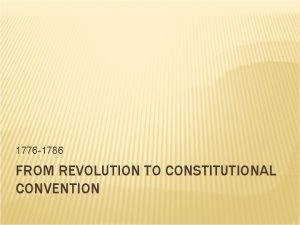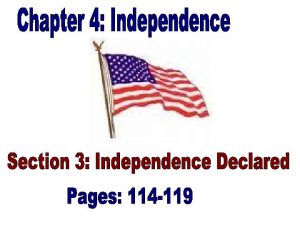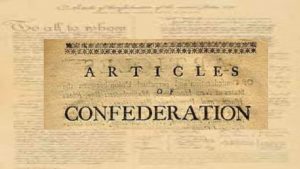The American Revolution 1776 1781 First Continental Congress

























- Slides: 25

The American Revolution 1776 -1781

First Continental Congress �In 1774, All colonies except Georgia sent a representative to Philadelphia, Pennsylvania! � They draft a Declaration of Rights and Grievances which they send to King George III � They threaten to form a united front to stop buying British goods (Non-importation)

The Battle of Lexington and Concord

April 1775 � Paul Revere (and friend’s) ride to Concord, via Lexington, to warn that “The British are Coming!” � The minutemen prepare and are ready for the redcoats when they arrive in Lexington on their way to Concord to seize the arsenal. � The Shot Heard ‘Round the World” – the first battle of the Revolutionary War begins at the minutemen and redcoats fire upon each other on the village green. � The minutemen stop the redcoats at the Old North Bridge in Concord and send them running back to Boston

Second Continental Congress ØThey created the Continental Army, with George Washington as its commander ØThey begin printing American currency, called Continentals ØThey sent the Olive Branch Petition to King George III…. he responded by calling the colonies “open and avowed enemies”

The Battle of Bunker Hill

June 1775 (Actually took place on Breed’s Hill!) �Deadliest battle of the war �Gage sends 2400 redcoats to attack the colonial militia encamped near Boston at Breed’s Hill �The milita was ordered to hold their fire until “you see the whites of their eyes” – in an effort to effectively use their limited ammunition. �It took several attacks for the Brits to succeed, but, they won only because the militia ran out of ammo �Colonists took back the hill 4 days later with the help of GW! �losses: colonies 311, Brits 1000+

The Declaration of Independence On July 4, 1776 The Declaration of Independence , having been written by Thomas Jefferson, John Adams, Benjamin Franklin, Roger Sherman, and Robert Livingston, was signed, published, and sent out to be read throughout the colonies!

The Battle of Princeton

Dec 1776 – January 1777 �Washington led his men across the Delaware River (again) to back-up another Continental Regiment and protect Philadelphia �Defeated the British that were aided by Hessians �Provided a much needed victory to boost morale - many soldiers decide to re-enlist!

The Battle of Saratoga Victory for the American forces! General John Burgoyne American confidence high British confidence low General Horatio Gates

Saratoga - Oct 1777 �MAJOR Turning Point �British Gen. Burgoyne plans to move his army to Albany following a route of lakes in order to join Howe’s army �He had 4000 redcoats, 3000 mercenaries, 1000 Mohawks & 30 wagons of supplies �Burgoyne did not know that Howe was preoccupied with attacking Philadelphia and the disbursing the Second Continental Congress �Burgoyne is surrounded at Saratoga and surrenders to Gen. Horatio Gates �Proved that the Continental Army could defeat the Brits in traditional warfare with less soldiers �Heavy blow to Brit confidence �Also encouraged the French to openly support the Revolution after Benjamin Franklin’s request!

Valley Forge

Winter 1777 -78 �After the fall of Philadelphia George Washington and his troops retreat to the hillside �There was very little money for supplies as the Congress was not fully functioning �Over 2000 of the troops died due to starvation, disease and difficult weather conditions �The troops spent the winter training with the famous Prussian drill master Baron Friedrich von Steuben and preparing for war �France and Spain solidify their desire and ability to help the cause!

The Capture of Savannah December 1778 �The war moves to the South…the British feel that attacking the colonists on two fronts will weaken their chance of Independence! �The British capture the port city and now control trade (and the economy) in the South. �Many patriots retreat to the foothills of the Appalachian Mountains!

The Battle of Cowpens January 1781 �Turning point in the South…. as the war moves north through the Carolinas! �British General Tarleton is defeated by colonial General Morgan. �The “double envelope” proves useful in surrounding the British, creating many casualties, and forcing the survivors to retreat toward the coast.

The Battle of Guilford’s Courthouse March 1781 �A loss to the Colonists, but a bad maneuver by Cornwallis. �The wounded Colonial soldiers retreat and recoup in area plantations. �Cornwallis heads north to the Dan River and eventually Yorktown (through Great Bridge, Virginia)– on the advise of a spy!

The Battle OFF the Capes (aka: The Battle of Chesapeake)

September 1781 �French naval forces lead by Admiral de Grasse defeat a British fleet that are attempting to enter the Chesapeake Bay �They blockade the entrance to the Bay preventing the resupply and/or evacuation of Cornwallis’s troops at Yorktown �This assistance is crucial to the success of George Washington’s plan to win the war!

The Battle of Yorktown George Washington October 17, 1781 Marquis Charles Cornwallis de Lafayette

Yorktown - Oct 17, 1781 � 6000 French troops arrive & Lafayette suggests joining all forces to attack Yorktown, VA where Gen. Charles Cornwallis is fortifying � 17, 000 French and American troops surround Yorktown peninsula and bombard them for about a month �Cornwallis finally surrenders! He sends a lower officer to present Washington with the Articles of Capitulation as his formal surrender. �Independence is won!

Treaty of Paris - Sept 1783 �Colonists, Great Britain, France, Spain �Colonial negotiators: John Adams, Ben Franklin, John Jay �demands Britain recognize Colonial independence before any negotiations begin �set the border from the Atlantic to Mississippi River & from Canada to Florida �does not specify when the Brits would evacuate American forts �British creditors were allowed to collect debts owed to them by Colonists

A Symbol of Liberty With the signing of the Treaty of Paris, all European nations recognized the “United States of America”. Former British subjects now possessed a new identity as free Americans, loyal to a new ideal. The American Revolution would inspire the world as both a democratic revolution and a war for independence.


 First continental congress convenes
First continental congress convenes First continental congress
First continental congress What was the goal of the first continental congress?
What was the goal of the first continental congress? First continental congress convenes
First continental congress convenes The first continental congress
The first continental congress You should hope that this game will be over soon
You should hope that this game will be over soon Divergent vs convergent boundaries
Divergent vs convergent boundaries Convergent plate boundary
Convergent plate boundary Jupiter spins once on its axis in a little less than
Jupiter spins once on its axis in a little less than Bolzano (1781 – 1848)
Bolzano (1781 – 1848) The united states in the caribbean 1776-1985
The united states in the caribbean 1776-1985 Middle colonies timeline
Middle colonies timeline Ccc1776
Ccc1776 What experiences from 1763 to 1776
What experiences from 1763 to 1776 1776-1607
1776-1607 What is the significance of july 4 1776 brainpop
What is the significance of july 4 1776 brainpop David hume 1711 a 1776
David hume 1711 a 1776 January 10th 1776
January 10th 1776 Nadja farshad
Nadja farshad July 12 1776
July 12 1776 1787-1776
1787-1776 1776 divided by 3
1776 divided by 3 July 16 1776
July 16 1776 Russian revolution vs french revolution
Russian revolution vs french revolution Modern commercial agriculture
Modern commercial agriculture Causes of the american revolutionary war
Causes of the american revolutionary war
